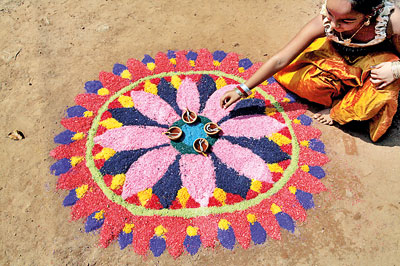Celebration of tradition and harmony

Making Aasmi: A delicacy on the Sinhala New Year table
The Sinhala and Tamil New Year or the Aluth Avuruddha goes deep into the roots of Lankan history. With astronomy and astrology tied to rituals that touched the lives of Lankans, the Aluth Avuruddha has survived. And withstanding foreign conquests, it has emerged as Sri Lanka’s premier national festival.
According to anthropologists, the Aluth Avuruddha has its origins in the “kamatha” – the threshing floor in the paddy field where took place the joyful celebration of the Maha harvest. The Maha harvest was the outcome of the laborious work in the paddy field which provided people their staple food. The Aluth Avuruddha therefore, is a reflection of a well organized, vibrant agrarian society that once existed. Our ancestors may have been craftsmen, rulers, administrators or ingenious engineers who built giant reservoirs, amazing irrigation canals and the largest dagobas on earth. Yet, they were all essentially paddy cultivators. With their harvest season happily coinciding with the completion of the sun’s journey, they began the New Year when the sun from the twelfth zodiac sign of Pisces moved to Aries – the first zodiac sign.
To commence the New Year in accordance with astrological directions, they chose rituals that affect their daily lives. And these rituals, which over the years gained mass participation, took root and have now been practised for several thousands of years.
And being an event of merriment, their joy made way for many Avurudhu games to take shape. “Olinda keliya”, “pancha dameema”, “ daan adeema” were essentially indoor games while the giggling damsels found fun swinging in the “onchillawa”. Group games were part of the Aluth Avurudhu Ulela or Sanakeliya, held once again on the paddy field which served as a play field till the next season of paddy cultivation began.
The present generation, rural or urban, may not be as familiar with the fun and frolic and the gaiety associated with the Avuruddha, unless these come alive at places of work or are sponsored by commercial outfits. We however, find Avurudhu rituals and traditions being practised in homes as vigorously as was in the past and the Aluth Avuruddha, an authentic folk celebration, inherited from our earliest ancestors, is being continued.
Robert Knox called the Aluth Avuruddha, the greatest feast of the Sinhala race in his “An Historical Relation of the Island Ceylon.” Describing the historical scenario of the peasants of the Kandyan kingdom in the 1660s he wrote: Men who had been toiling in the fields had brought the paddy home from the Maha cultivation. It was thereafter the turn of the womenfolk to pound the paddy, winnow and have the rice ready for the array of preparations to be made from kiribath, the festive meal to the making of numerous “avurudhu kevilli”.

Kolam: A custom associated with Hindu New Year celebrations
During the days of the Kandyan kingdom, the Sinhala and the Nayakkara kings observed New Year customs and led the anointing of nanu, an act which displayed the patronage of kings in the observation of Avurudhu rituals.
Eminent writer Martin Wickremasinghe (1890-1978) sees the Aluth Avuruddha as the ideal occasion to bring about national harmony. In an article he wrote on “How the Aluth Avuruddha became the National Festival” to Rasavahini in 1970, he had stated that the Avuruddha should be celebrated by the Sinhalese, Tamils and the Muslims unitedly and should be an event that infuses a nationalistic ethos.
Very socialistic in his views he had besides pointed out that the avurudhu celebration is a great leveller as it had no class distinction. Within the household, the family as well as all those who served in the household or in the paddy field celebrated the Aluth Avuruddha together.
“They all stood around the festive table or sat around the festive mat when they partook of the festive meal and observed the rituals. The Chief householder fed kiribath to those who served them at the same time he did his family members.”
Once the feast was over, it was the turn of the younger members to offer betel leaves to the elders and worship them, going down on their knees. Showing respect to elders was a hallmark of Lankan culture. This followed transactions or “ganu denu” after which the younger members proceeded to play avurudhu games. The anointing ceremony was the last ritual that took place before setting out to work.
Wickremasinghe’s celebrated “Gam Peraliya” takes you back to a scenario of the early 20th century which shows as to how people of the deep south celebrated the Avuruddha, the customs they followed, games they played and sweetmeats they savoured – indeed a wealth of cultural information for those interested to learn as to how the Aluth Avuruddha was celebrated 200 years ago.


